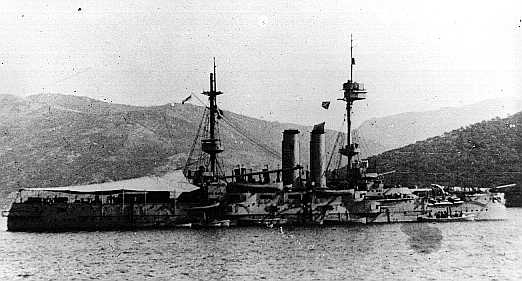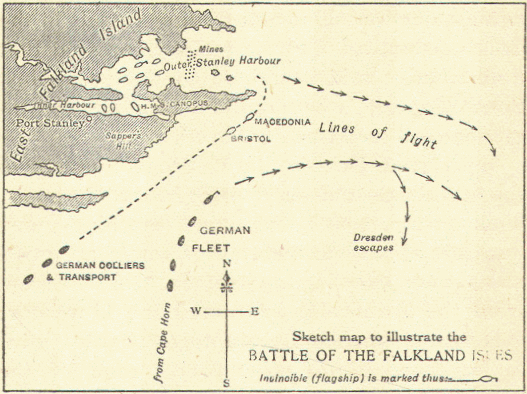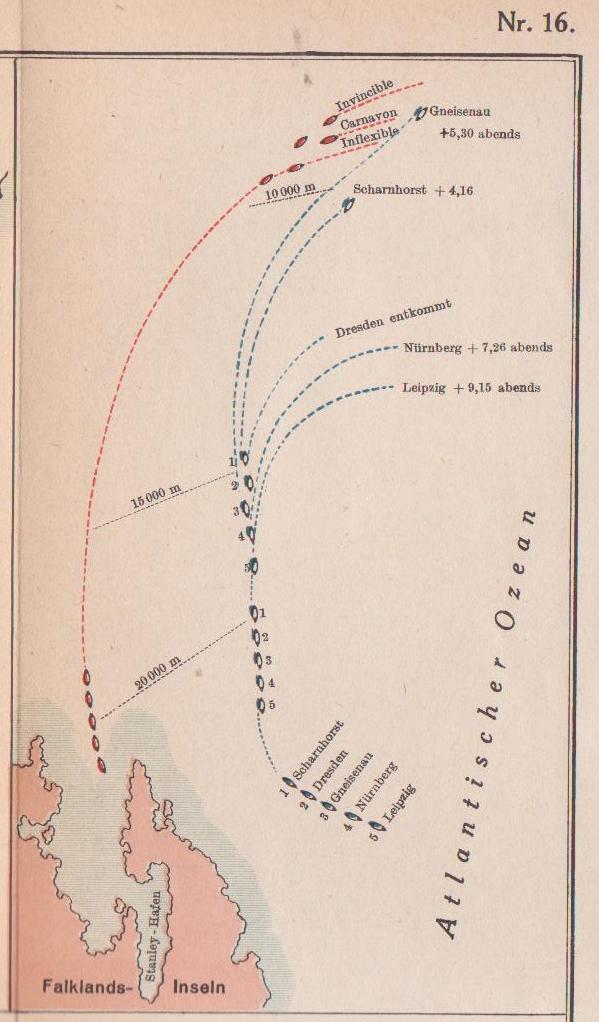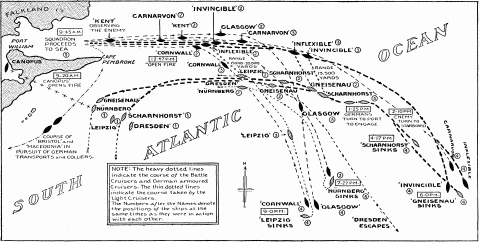Fullbore Friday
Naval History Magazine has an article (membership required) out in the latest edition about the WWI Battlecruiser HMS Invincible. It reminded me of a FbF I did back in 2007 on the WWI Battle of the Falkland Islands. Let's revisit.
 Time for Part 2 ... of 3 of the story of Admiral Graf Maximilian von Spee' glorious and beautiful, but doomed fleet. It is time for a classic story of revenge at sea: The Battle of the Falkland Islands, 8 December 1914. I like to pay a lot of attention to HMS Canopus. If you review Part 1, you will see how you could dismiss this old ship full of Reservists; but it that what a leader does? No, a leader finds a way to make every bit of kit count.
Time for Part 2 ... of 3 of the story of Admiral Graf Maximilian von Spee' glorious and beautiful, but doomed fleet. It is time for a classic story of revenge at sea: The Battle of the Falkland Islands, 8 December 1914. I like to pay a lot of attention to HMS Canopus. If you review Part 1, you will see how you could dismiss this old ship full of Reservists; but it that what a leader does? No, a leader finds a way to make every bit of kit count.On November 11 1914 the battlecruisers Invincible and Inflexible under Admiral Sturdee left for the Falkland Islands. HMS Princess Royal was dispatched to the Caribbean to guard the Panama Canal. The shock of the defeat at Coronel had made the Royal Navy take decisive action to destroy Spee and the battlecruisers were the chosen means for retribution.
After his victory Spee coaled and then loitered in the Pacific whilst he decided what to do next, little did he realise that this indecision would prove fatal. Eventually he decided to enter the Atlantic and try to make it home. The squadron had passed Cape Horn by December 1 and on the following day they captured the Drummuir carrying coal. They then rested for three days at Pictou Island. Spee wanted to raid the Falkland Islands but his captains were opposed to the idea, however in the end Spee decided to go ahead anyway, another decision he was to regret.
 HMS Canopus was now beached at Port Stanley, the capital of the Falklands, as guard ship. On December 7 Sturdee arrived, bringing the British warships at Port Stanley to the pre-dreadnought Canopus, the battlecruisers Invincible and Inflexible, the armoured cruisers Kent, Carnarvon and Cornwall, the light cruisers Bristol and Glasgow and the armed merchant cruiser Macedonia.
HMS Canopus was now beached at Port Stanley, the capital of the Falklands, as guard ship. On December 7 Sturdee arrived, bringing the British warships at Port Stanley to the pre-dreadnought Canopus, the battlecruisers Invincible and Inflexible, the armoured cruisers Kent, Carnarvon and Cornwall, the light cruisers Bristol and Glasgow and the armed merchant cruiser Macedonia.
On the morning of December 8 1914 Gneisenau and Nürnberg were detached from the main squadron, which followed about fifteen miles behind, to attack the wireless station and port facilities at Port Stanley. At 0830 they sighted the wireless mast and smoke from Macedonia returning from patrol.
They didn't know that at 0750 they had been sighted by a hill top spotter which signalled Canopus which then signalled Invincible, flagship, via Glasgow. The British ships were still coaling and most ships, including the battlecruisers, would take a couple of hours to get up steam. If the Germans attacked the British ships would be stationary targets and any ship which tried to leave harbour would face the concentrated fire of the full German squadron, if they were sunk whilst leaving harbour the rest of the squadron would be trapped in port. Sturdee kept calm, ordered steam to be raised and then went and had breakfast!
0900 the Germans made out the tripod masts of capital ships. They were unsure of what theses ships were but they knew Canopus was in the area and they hoped that these were pre-dreadnoughts, which they could easily outrun.
Canopus was beached out of site of the German ships, behind hills but had set up a system for targeting using land based spotters. At 13,000 yards her forward turret fired but was well short, the massive shell splashes astonished the German ships who could see no enemy warships. The rear turret then fired using practice rounds which were already loaded for an expected practice shoot later. The blank shells ricocheted off the sea, one of them hitting the rearmost funnel of Gneisenau. The two German ships turned away. Canopus didn't fire again but she saved the British from a perilous situation.
Also a lesson on not pressing the attack and getting spooked. Probably remembering what happened when the British pushed the attack against his Squadron and were sunk for it - Admiral Graf Spee was too cautious by half, perhaps with a bit of "get-home-itis," a disease that will get you killed.
By 0945 Bristol had left harbour, followed 15 minutes later by Invincible, Inflexible, Kent, Carnarvon and Cornwall, Bristol and Macedonia stayed behind. The German squadron had a 15-20 mile lead but with over eight hours of daylight left and fine weather the battlecruisers would be in action in a couple of hours.
The German lookouts could now tell that the tripod masts belonged to battlecruisers which at c25 knots were considerably faster than the 20 knots the in need of refit German ships could manage. Spee set course to the South East in the hope of finding bad weather.
At first the British squadron stayed together but the battlecruisers were being slowed down by the other ships and so pulled ahead on their own.
At 1247 at 16,500 yards the battlecruisers opened fire, with little accuracy, taking half an hour to straddle the rear ship, Leipzig. Spee realised he was caught and turned his armoured cruisers to slow the British whilst ordering his light cruisers to try and escape. Sturdee had made contingency plans for this and Invincible, Inflexible and the trailing Carnarvon engaged the armoured cruisers whilst the rest of the force set off after the light cruisers.
The battlecruisers turned onto a parallel course to Scharnhorst and Gneisenau at 14,000 yards. The Germans had the advantage of being in the lee position of the wind, the British gunnery was badly affected by their own smoke. The German shooting was excellent but at this long range their shells did little damage to the battlecruisers. The British also scored a few hits which did more damage but they were unaware of this as the visibility prevented them from seeing these.
In an attempt to gain the lee (smoke free) position Sturdee made a sharp turn to starboard towards Spee's stern. Whilst performing this turn the British were shrouded in their own smoke and Spee took this opportunity to turn south, pulling out of firing range. It took the British another 45 minute stern chase before they could resume firing.
At 1450 the battlecruisers turned to port to bring their broadsides to bear. Spee decided that his only chance was to close the range and use his superior secondary armament but his change of course made the smoke much less of a problem for the British. Their firing became much more accurate and both German ships, but especially Scharnhorst suffered severe damage and casualties. By had received over fifty hits, three funnels were down, she was on fire and listing. The range kept falling and at 1604 Scharnhorst listed suddenly to port and by 1617 she had disappeared. As Gneisenau was still firing no rescue attempts were possible and her entire crew including Spee were lost. Invincible had received 22 hits, over half 8.2 inch, but these caused no serious damage and only one crew member was injured.
Gneisenau kept on alone, zigzagging to the south west. At 1715 she scored her last hit on Invincible before her ammunition ran out. The British stopped firing soon afterwards and the burning German ship ground to a halt, her crew opening the sea-cocks and abandoning ship, 190 crew from a total of 765 were rescued but many of these died from their wounds. Inflexible was only hit 3 times and had 1 killed and 3 injured.
The brutal facts of war at sea. There is little room for caution or pause. Whilst the big ships were fighting the smaller cruisers were having their own battles. The German light cruisers were in the order Dresden leading followed by Nürnberg and Leipzig whilst the British were led by Glasgow with Cornwall and Kent trying to keep up with her.
Whilst the big ships were fighting the smaller cruisers were having their own battles. The German light cruisers were in the order Dresden leading followed by Nürnberg and Leipzig whilst the British were led by Glasgow with Cornwall and Kent trying to keep up with her.
At 1445 Glasgow opened fire on Leipzig, Leipzig turning to port to reply, scoring two early ships whilst Glasgow's fell short. Glasgow had to turn away, allowing Leipzig to resume her earlier course. The other German ships had not turned to help Leipzig but had carried on their escape attempt.
Glasgow fired on Leipzig again, but this time the other German cruisers changed course, Dresden to the South West and Nürnberg to the South East. Glasgow's ploy of forcing Leipzig to turn and fire succeeded in slowing her so that at 1617 Cornwall had her in range, Kent setting off after Nürnberg.
Leipzig's firing was good but she didn't hit Glasgow and her shells didn't do much damage to Cornwall. By 1900 Leipzig's mainmast and two funnels were down and she was on fire. When her ammunition was exhausted she made an unsuccessful torpedo attack on Cornwall and then her crew prepared to abandon ship.
Glasgow closed the range to finish her off as her flag was still flying, stopping when two green flares were fired by the crippled German cruiser. At 2120 she rolled over and sank leaving eighteen survivors.
Cornwall had received eighteen hits but no casualties. Glasgow had received no damage after the two early hits which killed one and four wounded. Her boilers were damaged which reduced her speed enough for there to be no chance of catching Dresden which escaped.
Nürnberg had a 10 mile led on Kent and was, on paper, faster, but Nürnberg needed an engine overhaul and Kent's crew worked so hard that the old cruiser exceeded her designed horsepower, reaching 25 knots, being forced to burn all available wood on board and causing the whole ship to vibrate violently.
By 1700 the range was down to 12,000 yards and Nürnberg opened fire with the by now expected superb accuracy. When Kent returned fire ten minutes later her shells fell short. Once the range had fallen to 7,000 yards both sides started to score regular hits and Nürnberg gave up her escape attempt and turned to bring her broadside to action.
By 1730 the range was down to 3,000 yards and Kent's heavier shells and thicker armour gave her the upper hand. An hour later, just as bad weather arrived which may have saved her, two of Nürnberg's boilers exploded, reducing her speed. Kent was now able to easily outmanoeuvre her opponent and within half an hour Nürnberg was dead in the water, at 1926 she rolled over to starboard and sank with only twelve survivors.
Kent had received thirty eight hits but only sixteen casualties.
Whilst these battles had gone on Bristol and Macedonia had sunk Spee's colliers Baden and Santa Isabel, the other collier, Seydlitz escaped, eventually being interned in Argentina.
Even in victory, you will be second guessed by those who don't know; they just don't know but their petty concerns.Sturdee searched for the Dresden before returning to the UK with the battlecruisers. There was some criticism (mainly from the 1st Sea Lord Fisher) of him for letting Dresden escape and for the heavy ammunition expenditure of his battlecruisers (Invincible 513 12 inch rounds, Inflexible 661 12 inch rounds fired) but generally his clear victory was welcomed. He had destroyed Spee's squadron without any serious damage to any of his ships and their shooting (c.6.5%) was considerably better than was managed by British (and German) battlecruisers at Dogger Bank and Jutland.
Ah, the SMS Dresden. That will be Part 3, with a twist. See you there in March.
 Time for Part 2 ... of 3 of the story of Admiral Graf Maximilian von Spee' glorious and beautiful, but doomed fleet. It is time for a classic story of revenge at sea: The Battle of the Falkland Islands, 8 December 1914. I like to pay a lot of attention to HMS Canopus. If you review Part 1, you will see how you could dismiss this old ship full of Reservists; but it that what a leader does? No, a leader finds a way to make every bit of kit count.
Time for Part 2 ... of 3 of the story of Admiral Graf Maximilian von Spee' glorious and beautiful, but doomed fleet. It is time for a classic story of revenge at sea: The Battle of the Falkland Islands, 8 December 1914. I like to pay a lot of attention to HMS Canopus. If you review Part 1, you will see how you could dismiss this old ship full of Reservists; but it that what a leader does? No, a leader finds a way to make every bit of kit count.HMS Canopus was now beached at Port Stanley, the capital of the Falklands, as guard ship. On December 7 Sturdee arrived, bringing the British warships at Port Stanley to the pre-dreadnought Canopus, the battlecruisers Invincible and Inflexible, the armoured cruisers Kent, Carnarvon and Cornwall, the light cruisers Bristol and Glasgow and the armed merchant cruiser Macedonia.
Whilst the big ships were fighting the smaller cruisers were having their own battles. The German light cruisers were in the order Dresden leading followed by Nürnberg and Leipzig whilst the British were led by Glasgow with Cornwall and Kent trying to keep up with her.

This is perhaps the only instance of Jackie Fisher's "cats" being employed in the role for which they were initially conceived.
ReplyDeleteOne has to wonder how much the illusion of abosorbing punishment from 8.2" guns influenced the concept of employing battle cruisers against battleships and other battle cruisers...
Invincible had just over 18 months to live. What killed her and her sisters almost killed Seydlitz at Dogger Bank six weeks after the Falklands battle (potential for a turret fire to reach powder handling and powder magazines). Germany modified all of its Dreadnoughts to safeguard against such an occurrence. Britain, without the experience of a near-disaster, did not.
in fact the inherent flaw of the British battlecruisers persisted until the demise of Hood in the 1941 battle with the Bismarck....
ReplyDeleteThe US Navy in the War of 1812 taught the RN the value of "good shooting". Looks like they took the lesson to heart.
ReplyDeleteIndeed. And there were several instances before and between the wars where the Royal Navy's cavalier handling of powders was evident. The Germans, interestingly, used brass casings to reduce the chances of flash fires from hot splinters.
ReplyDeleteThe RN paid the price for their failure to learn the hard lessons.
Only in part. URR is dead on target. The British used very poor powder handling practices. If fire reached a magazine, an explosion was likely. The Germans dodged that cannonball, learned their lesson to heart.
ReplyDeleteI think part of the use of BCs was that they were fast and hard-hitting. An admiral looking for a fast strike force wanted fast BBs...but BCs would do.
ReplyDeleteThe Batte of the Fakland Islands has always touched me. A lot of brave, honorable men, stranded halfway around the world, trying to fight their way home.
ReplyDeleteIndeed, Maximillian Graf von Spee would perish, along with sons Otto (aboard Nurnberg) and Heinrich (Gneisenau) in the battle. Otto was 24, Heinrich, 21.
ReplyDelete(Ewok & URR)...although for twenty years before the loss of Hood, the defect was known and a fix available, it was deferred due to lack of funds.
ReplyDeleteFunding was based on a formal position that no threat of major war existed for at least a decade in the future, which was renewed each year until the German threat became imminent and obvious. Then a shortage of industrial capacity for shipalts existed due to the high priority assigned to new construction.
Those who will not learn from history are doomed to repeat it.
Mike M: It was only in mid-30s that new designs of BBs caught up in speed to BCs, with some older classes like British QE gaining speed thru modernization. Plethora of various factors, including the treaty limitations resulted in many of mid-30s BB designs in being sub-optimal (280mm guns on Scharnhorst, 356mm on KG V, etc.) - it was only when those limits were truly gone the apex classes of Bismarck, Yamato and Iowa were created. Alas, the new breed of capital ship, the carrier has moved the BBs into the supporting position by then...
ReplyDeleteGrandpa: what is important, Brits got their limited funds concentrated on things that proved invaluable, Radar and modern fighters in the shape of Hurricane and Spitfire. French by comparison, dumped money and resources into the Maginot line...
URR: Germans not only were more masterful in handling gunpowder, they perfected the watertight compartmentalization of their capital ships almost to the level of "honeycomb" structure which was evident in the amount of punishment Bismarck and Tirpitz were able to take...
You are correct, GBW. Hood never got her refit.
ReplyDeleteYes, no major threats. No war for ten years. What a solid, realistic, well-grounded National Security Strategy. Right as rain in 1928. Not so much in 1938.
Kinda like having a Maritime Strategy knowing you haven't the hulls or capabilities to execute half of it....
yeah but the germans had a bad habit of running control/information cables across the open deck where they could be hit easily rather than at least under the splinter decks and best below the armor decks to protect them from incomming.
ReplyDeletesupposedly loss of bismarck can be traced directly to that in that biz had to shift to local control of the main turret that was not masked at the worst possible time.
C
Mike M.
ReplyDeleteThe battle cruisers were fast and hard-hitting. But the original concept of employment was to overwhelm and outgun the enemy "scout cruisers" which were the eyes of a rival fleet.
The RN had ships with a heavyweight punch and a welterweight jaw. Whereas the High Seas Fleet had ships with a cruiserweight punch and superheavyweight jaw.
And the Mackensens would have had a heavyweight punch. They were, in fact, the first true fast battleships. Four knots faster than the Queen Elizabeths. The threat of these ships was sufficient to spawn the Hoods.
True bane of Bismarck was a single torpedo delivered by Swordfish, that rendered steering mechanism unusable and eventually forced it ot run in circles... unable to maneuver freely she was eventually surrounded by superior forces and outgunned decisively. It was a sign of things to come that it was carrier plane that decided the fate of Bismarck...
ReplyDeleteIn fact Bismarck was pretty much evolution from the Mackensen design...
ReplyDeleteYes, and it is interesting to see the merging of the battleship/battle cruiser designs as the Badens and the Mackensens began to resemble each other in appearance, armament, and even protection.
ReplyDeleteOne of the things we should note is how the same names will pop up later in history - from Scharnhorst and Gneisenau, to the namesake of the admiral Spee that would end not so far from the area of the battle, to another Invincible leading another RN task force decades later to retake Falklands from another foe...
ReplyDeleteAnd one German Naval Lieutenant named Canaris, who was the only one to escape from Dresden, and would have a cloak and dagger affair across two continents. And would wind up in the employ of his country in the next war, too.
ReplyDeleteyep, but my point would be rather, then why can't USN have another Enterprise????
ReplyDeleteTradition is so overrated. After all, didn't our First Lady wonder openly about all the fuss for just a FLAG?
ReplyDeleteAll tradition gives you is pride in service, examples of courage and leadership, identity, professionalism, and espirit.
Tradition isn't new and exciting, it isn't "outside the box", it is hardly transformational, and sure as hell isn't Diverse.
ewok: it wasn't limited funds, there was credit from the US and some of the capital ships that put paid to Bismark a few days after she sank the Hood were already scheduled for US yards to overhaul them. It was lost industrial capacity in the interwar years, due, in part, to small orders for new ships from the Royal Navy. The Brits went to war with the Navy they had, the cost of the missed opportunities from lack of prudent proper prior planning was lethal to Hood's sailors (with three very lucky exceptions), and, in the fullness of time, to the British Empire.
ReplyDeleteIndustrial base is the foundation of logistics, and logistics rules. Forget that at your (children's) peril.